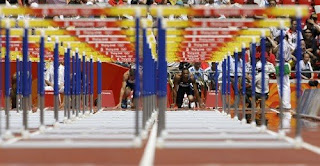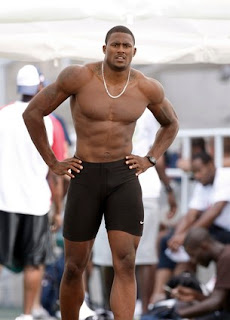I believe it's only right for my first Athlete Spotlight series post go to someone I truly admire. I had the pleasure of meeting this person in college and actually witness his greatness in the making and I've been a fan every since. Mark my words: David Oliver is one of the hardest working, best athlete's doing it right now (I may be partial because he's a fellow Howard alum, but hey, it's still true)! If you're into fitness and sports and don't know who he is, please let me enlighten you. David Oliver (known as D.O. during my college tenure with him) represented the
D.O. winning the Olympic trials in Eugene July 6, 2008 )
For the past four years, D.O. has been training hard and steadily making his mark in the Track and Field circuit. All of this has been achieved in such a short period of time, which indicates that D.O. not only had to work hard, but it was done quickly and efficiently with tremendous dedication! His regimen and dedication to the fitness aspect of his career would make any trainer proud. With workouts that include 9 continuous 300 meter sprints designed to leave even the best athletes puffing and huffing (an even vomiting, as D.O. has admitted) and heavy weight regimens, it's plain to see that D.O. works extremely hard fitness wise, which has garnered him much success. This success has translated into a bronze medal at the 2008 Olympics and holding three of the top 5 times for his event this year!
HURDLES WORKOUTS / EXERCISES:
(use small fitness sized hurdles for necessary workouts)
Quick Steps:
Set up five to ten hurdles, approximately six yards apart from each other. (6 steps for smaller, controlled spaces) If your focus is on quickness, then keep the number of hurdles low (five to seven); if your focus is on endurance, then raise the number of hurdles (eight to ten). With the first hurdle on the regular mark, the hurdler should take a quick-stepping, high-knee approach to the first hurdle, getting to it in nine or ten steps. If you get to the first hurdle in eight steps, you’re going too fast. Slow down. This is a quickness drill, not a speed drill. For each rep, clear all the hurdles as quickly as possible, taking short, quick strides between the hurdles. If you’re feeling crowded, then good, that’s how you should feel. The more crowded you feel, the quicker you have to be, both between the hurdles and over top of them. Force yourself to be quick. Rest between reps should be to jog or bounce on the balls of the feet back to the starting line if the focus of the workout is to improve endurance, or to walk back to the starting line if the focus of the workout is to improve quickness. When emphasizing quickness, clear somewhere in the neighborhood of 100-140 hurdles for a full workout, broken into two sets of 10. When emphasizing endurance, clear somewhere in the neighborhood of 240-300 hurdles, broken into three sets of 10.
Super Quick 3 Step Drill:
This one is similar to the quick-step workout, but the hurdles are even closer together. Set up eight to ten hurdles five yards apart from each other (3 feet for smaller spaces). In the workout, do super-quick three-step reps over the hurdles. Between the hurdles, there will not be enough room or time to drive the knees or pump the arms. Because the knees are low and the arms are not driving between the hurdles, quickly thrust the lead-leg knee upward with a quick, explosive push off the ground over each hurdle.
Ins and Outs:
In this workout, you sprint the straight-aways and jog the curves, (every 0.25 on a treadmill alternates between the straights and curves) running a total of anywhere between two to four miles, sprinting and jogging combined. The sprints should be run at about 75% - 85% of full speed. The jog between should be more of a bounce/shuffle, not a distance runner’s fast-paced jog. The focus of this workout is on maintaining efficient sprinting mechanics, staying relaxed in the upper body, and developing cardiovascular strength.




1 comments:
Its amazing how the guys from college grow up so "nicely"...lol
Post a Comment